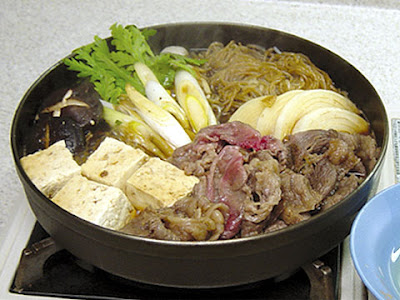1. Miso Soup
2. RAMEN
It consists of Chinese-style wheat noodles served in a meat- or fish-based broth, often flavored with soy sauce or miso, and uses toppings such as sliced pork (チャーシュー chāshū), dried seaweed (海苔 nori), kamaboko, green onions, and occasionally corn. Almost every locality in Japan has its own variation of ramen, from the tonkotsu (pork bone broth) ramen of Kyushu to the miso ramen of Hokkaido. You can find a ramen shop everywhere in Japan. I love ramen so much.
3. SASHIMI
Sashimi : 刺身 is a Japanese delicacy. It primarily consists of very fresh raw seafood, sliced into thin pieces, and served only with a dipping sauce (soy sauce with wasabi paste or such condiments as grated fresh ginger, or ponzu), and such garnishes as shiso and shredded daikon radish. It is absolutely delicious.
4. SUKIYAKI
It consists of meat (usually thinly sliced beef) which is slowly cooked or simmered at the table, alongside vegetables and other ingredients, in a shallow iron pot in a mixture of soy sauce, sugar, and mirin. Before being eaten, the ingredients are usually dipped in a small bowl of raw, beaten eggs.
Generally sukiyaki is a winter dish and it is commonly found at bōnenkai, Japanese year-end parties.
5. TOFU
Tofu contains a low amount of calories, relatively large amount of iron, and little fat. Depending on the coagulant used in manufacturing, the tofu may also be high in calcium and/or magnesium.
6. TAKOYAKI
I wil never forget my dirst Japanese food......I love it so much. Takoyaki (たこ焼き or 蛸焼) (literally fried or grilled octopus) is a popular ball-shaped Japanese dumpling or more like a savory pancake made of batter and cooked in a special takoyaki pan (see below). It is typically filled with diced or whole baby octopus, tempura scraps (tenkasu), pickled ginger, and green onion.
In modern days, it became common to be brushed with takoyaki sauce and mayonnaise, and topped with green laver (aonori) and katsuobushi (shavings of dried bonito).
7. YAKITORI
The average yakitori is made from several bite-sized pieces of chicken meat, or chicken offal, skewered on a bamboo skewer and grilled, usually over charcoal.
Diners ordering yakitori usually have a choice of having it cooked with salt (shio) or with tare sauce, which is generally made up of mirin, sake, soy sauce and sugar. The sauce is applied to the skewered meat and is grilled until delicately cooked.
8. TENPURA
9. ONIGIRI
10. DANGO
Dango are eaten year-round, but the different varieties are traditionally eaten in given seasons. Three to four dango are often served on a skewer. I love dango.
11. WAGASHI
Wagashi is typically made from natural (mainly plant) ingredients. The names used for wagashi commonly fit a formula—a natural beauty and a word from ancient literature; they are thus often written with hyōgaiji (kanji that are not commonly used or known), and are glossed with furigana.
Generally, confections that were introduced from the West after the Meiji Restoration (1868) are not considered wagashi. Most sorts of Okinawan confectionery and those originating in Europe or China that use ingredients alien to traditional Japanese cuisine, e.g., kasutera, are only rarely referred to as wagashi. Most wagashi are made entirely of plant-based ingredients.
This is just a taste of Japanese food. I hope you like it and don't be afraid of tasting it. I guarantee you will love it as much as I do.....Itadakimasu!!!!!












































